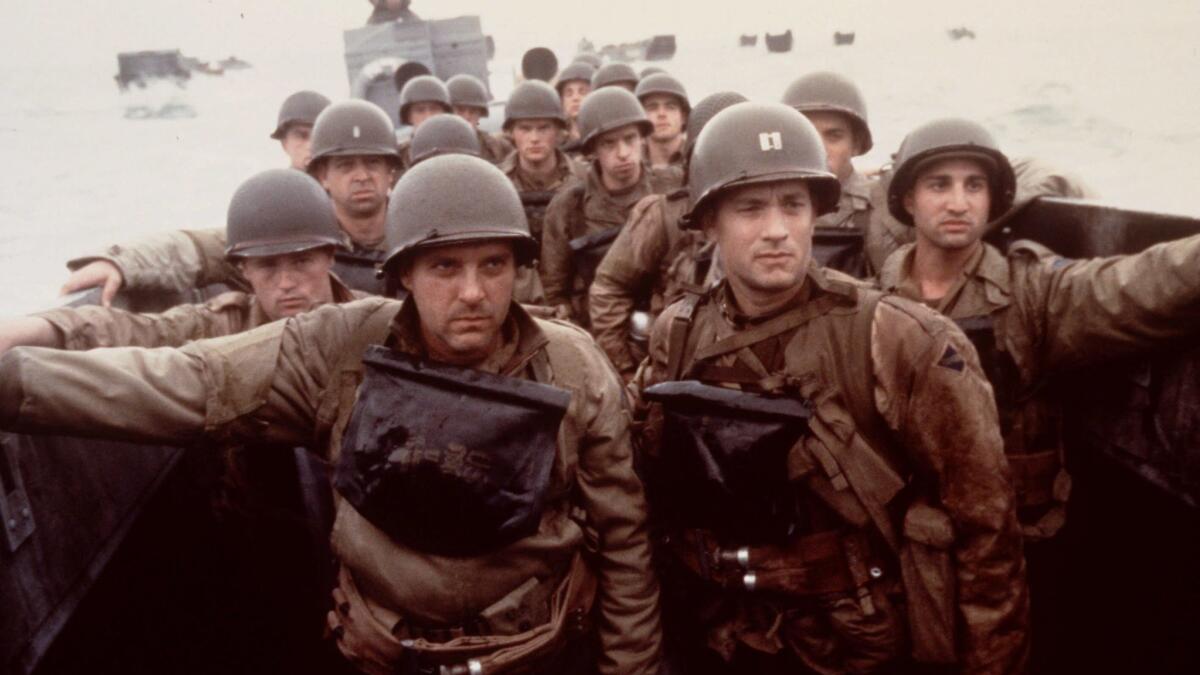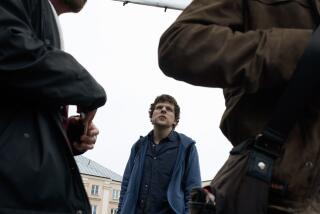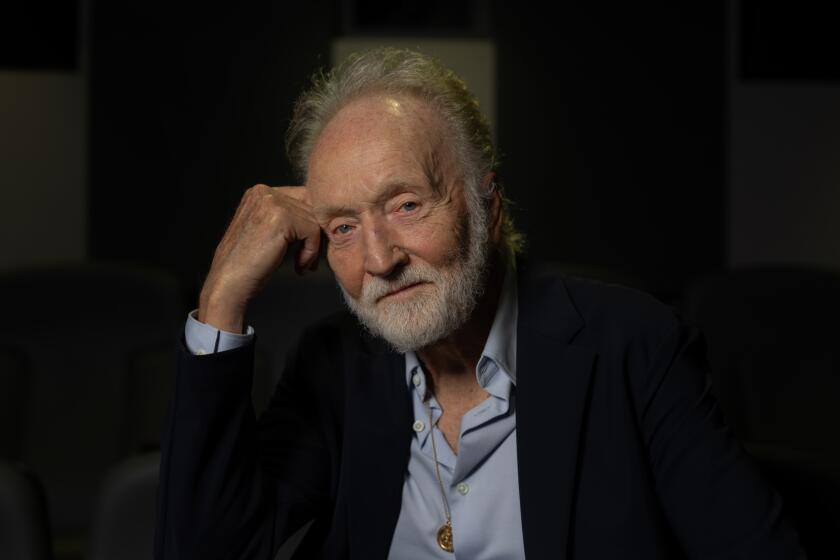‘Saving Private Ryan’ at 20: How Spielberg’s vivid D-Day story changed war movies forever
Twenty years ago, Tom Hanks’ Capt. John Miller looked up at Matt Damon’s young title character in “Saving Private Ryan” and whispered in a raspy voice, “Earn this.”
In essence, Miller was speaking about the great debt owed to the men and women of the armed forces — of any war — who made the ultimate sacrifice for their country. It was a movie and a message that resonated deeply with veterans and civilians alike. Director Steven Spielberg was lauded for making such a potent statement about war and sacrifice.
The truth, however, was that Spielberg wasn’t sure if anyone would see his film, which had been released in July 1998. (A special 4K DVD edition of the film was released this spring by Paramount.)
“I didn’t anticipate the success of the movie,” he says today. “In very early screenings, certain associates and other people in my life were saying that I made it too tough. I feared that almost nobody would see it because the word of mouth would spread quickly after the first 25 minutes.”
“Saving Private Ryan” has joined the pantheon of great war movies. It’s also heavily influenced every war picture since; the type of frenetic, no-holds-barred, filmmaking style that Spielberg brought to Omaha Beach, and later in the Alamo-like siege of the French village of Ramelle, has inspired a new generation of filmmakers — in film and television — who have adopted his style of putting the audience deep into the action. “Gladiator,” “Flags of Our Fathers,” “The Pacific,” “Hacksaw Ridge,” “Dunkirk” and certainly all of the high-action superhero films all owe a nod to “Private Ryan,” particularly the D-Day scene.
Audiences, indeed, were stunned by the opening dramatization of the U.S. landing on Omaha Beach. In jaw-dropping, realistic fashion, using every filmmaking technique in his toolbox, Spielberg showed American soldiers being annihilated by a seemingly unbreakable line of German fortifications, beach obstacles and firepower. In more than 50 years of World War II combat films, no major filmmaker had ever dared show so much.
And yet no modern filmmaker was more qualified to tell this story than Spielberg. It wasn’t just his ability to throw audiences into the midst of startling screen moments. Spielberg was a student of World War II, a man fascinated with the drama, the stakes, the history. Given a movie camera as a teenager, Spielberg could have picked any story and any genre to film. Out of the box, he chose to make World War II films.
Recalls Spielberg, “I picked World War II because, growing up, it was the seminal conversation inside my family. My parents talked about the Holocaust and they talked about World War II. And I was born knowing this. My dad was a veteran — he’s still with us, thank God, 101 years old — he was in the Army Air Corps from 1942 to the beginning of 1945.
“He had many veterans over to the house, and I became absolutely obsessed with the Second World War, based on my father’s stories, recollections and also based on all the World War II movies that eventually began playing on American television.”
Hanks was another teenager immersed in World War II history. Says Hanks today, “Starting in 1973, local Channel 2 up in Oakland ran ‘The World at War.’ I couldn’t get enough of it. And that tied into the connection that Steven and I shared, that we had grown up on an awful lot of fictional movies about World War II, or films that took moments from the war and then turned them into understandable morality plays like a certain type of genre movie.”
Hanks also points out that prior to “Private Ryan” there hadn’t been many major studio World War II combat films since “A Bridge Too Far,” over 20 years earlier. Says Hanks, “The concept of looking at military service in these wars had evolved into an examination of the constant human folly of going to war in the first place. `Catch-22’ and movies like `MASH’ had come along, and they weren’t about the struggles of combat.”
The international success of “Private Ryan” was not only due to the intensely realistic filmmaking by Spielberg, but also the entertaining story, based on a script by Robert Rodat, and the amazing team of actors assembled to tell an extraordinary story.
“It was probably my greatest professional experience and a major learning experience for me, both as a filmmaker and as an actor,” says Ed Burns, an independent filmmaker who was cast as Pvt. Reiben, the BAR (Browning Automatic Rifle) man.
Burns wasn’t the only filmmaker cast in the film. Vin Diesel had just completed two films — “Multi-Facial,” a short, and a feature film titled “Strays” — and miraculously for Diesel, Spielberg had seen them. Diesel had been auditioning for stage, film and television roles for years with little success. His turn toward filmmaking was his last effort to try to make an actual living in Hollywood. Diesel was working as a telemarketer, trying to make ends meet when Spielberg called him and changed his life virtually overnight.
“He asked me to meet him on the set of `Amistad’ ” recalls Diesel. “And I remember thinking, ‘How should I look?’ He’s writing a role for me based on my being a director, so what do I do here? And what was I going to say to him? I promised myself I wouldn’t say something he’s probably heard a thousand times, like, ‘I’m a big fan of your work.’ And, lo and behold, I get in front of him and he says, ‘I’m a fan of your work,’ and I say, ‘I’m such a fan of your work.’”
Like Vin Diesel’s Pvt. Carpazo character, Adam Goldberg’s Pvt. Mellish had not yet crystallized in the script. Says Goldberg, “My role wasn’t written in the movie until I was cast. During the auditions, we didn’t have scenes from `Saving Private Ryan.’ Everyone who read for the film read sides from ‘A Midnight Clear,’ a World War II movie from a few years before.” Like Burns and Diesel, Goldberg had just directed his own first feature, the drama “Scotch and Milk.”

Tom Sizemore, who won the part of Sgt. Horvath, right hand to Capt. Miller, wasn’t even supposed to be in the film. He was hired to play a key role in Terrence Malick’s “The Thin Red Line,” and he was about to leave for shooting in Australia when Spielberg came calling. Says Sizemore, “He came right out and said, ‘Do you want to go to Australia with Terry Malick or do you want to come to Great Britain and Ireland with me and Tom Hanks?’ And I told him I wanted to go to Great Britain and Ireland.”
Another actor who was summoned to the soundstage-based deck of the “Amistad” was Canadian actor Barry Pepper, who was then rooming with fellow Canadian Ryan Reynolds in the San Fernando Valley. For Spielberg, Pepper would transform into Tennessee sharpshooter Pvt. Jackson. Pepper was overwhelmed by the experience.
“It was a seminal experience for me because it was like being invited behind the curtain of Oz. Steven and his crew were operating on a total different level than I had ever witnessed — the scope of his vision, the attention to detail was beyond anything I had ever dreamed of.”
“Private Ryan” is packed with emotional combat scenes. One of the most gripping is a fight between Goldberg’s Mellish character and a German SS soldier. Says Goldberg, “I was originally just going to be shot in the final battle, when [senior military advisor] Capt. Dale Dye suggested that I get into a hand-to-hand combat fight, because one of the things I excelled in at boot camp was using the bayonet.
“So Steven and I started talking about it, about wanting it to be as realistic as possible. There was a lot more of what you saw in the rough cut — it was so graphic that Steven’s projectionist — who projected the dailies in Los Angeles — told him he can’t leave the scene in the movie. It’s too painful to watch. Remembering back, I think there was a lot more of me screaming how much it hurts.”
Speaking of painful scenes to watch, on the other side of the wall from Goldberg’s desperate fight stands actor Jeremy Davies’ unit translator, Cpl. Upham, frozen in place, unable to come to Mellish’s aide. That scene was literally invented on its shooting day by Spielberg, who was creating timeless moments, seemingly on the fly.
“Halfway through the shoot,” says Davies, “Steven took me aside and said he’d seen some of the dailies, and that he’d been inspired to start telling Ryan from Upham’s POV. He told me that Upham represented the audience more than any other character, given that, of course, most of us will never experience war, and Upham was only trained to serve as an interpreter in noncombat situations.”
Regarding the enigma of Hanks’ Capt. Miller character, Spielberg says, “Tom was the adult in the story. Tom has played adults and sometimes as an adult he’s played a kid. In this case, he brought something to the movie that I hadn’t seen Tom bring to any other movie before, and that was a stillness. I felt safe around him; I felt safe around his character. So when his hand shakes — and we played that hand shaking a lot — it was meant to discombobulate the audience.”
Adds Hanks, “One of the things we did was examine the true past of Charlie Company, 2nd Ranger Battalion, where they had been prior to D-Day, and we learned that their history stretched back to North Africa and the disaster of the Kasserine Pass. They had a protracted history of battle in World War II prior to D-Day … and from that, I discovered other avenues in to what [Miller’s] behavior was and what he was actually thinking. I think he was horribly afraid because he didn’t want to get more guys killed. And landing on that concept really changed everything.”
The Omaha Beach sequence was naturally the most challenging scene in the film. Baby boomer audiences had previously seen the 1962 version of the battle in Darryl F. Zanuck’s “The Longest Day.” However, it was shot from a distance, and Spielberg was determined to put his cameras right in the surf as the men came ashore.
Before shooting began, the director spoke with author Stephen E. Ambrose, considered one of the top World War II historians in the country. Says Spielberg, “Stephen Ambrose gave me contact information for some of the veterans who had actually stormed Omaha and Utah Beach on June 6th — he had interviewed a lot of them for his book ‘Citizen Soldiers’ — and I met with a couple of them.
“I remember one of the guys telling me the entire charge up the beach was a blur — not a blur to his memory, because he still remembered every single grain of sand when he had his face buried in it from that fusillade raining down on them from above. But he described how everything was not in focus for him. And he described the sounds, and he described the vibrations of every concussion of every 88 shell that hit the beach, which gave some of them bloody noses, rattled their ears. The ground would come up and slam into their faces from the concussions.”
Burns relates a story that occurred on the last day of shooting. “The very last scene we shot is the interior of the church — I think it was our only interior scene in the whole movie. At lunchtime, Tom takes the group of of us back behind the church; he’s got a bottle of Jack Daniels and a bunch of shot glasses. He pours us a shot and says, ‘Guys, I want to make a little toast about how great an experience it’s been working with all of you.’ Then he says, ‘I’ve been to the editing room and I’ve seen what Steven has cut so far, and I have good news and bad news.
“‘The good news is that we are making a pretty incredible film and if the movie turns out like I think it’s going to turn out, we’re all going to be part of film history. This is a movie that will live on long after we’re all gone. Generations will watch this movie after you’ve all passed. That’s the good news. The bad news is that it’s all downhill from here.”
Screenwriter and film historian Steven Jay Rubin is the author of “Combat Films: American Realism 1945-2010.”
More to Read
Only good movies
Get the Indie Focus newsletter, Mark Olsen's weekly guide to the world of cinema.
You may occasionally receive promotional content from the Los Angeles Times.










